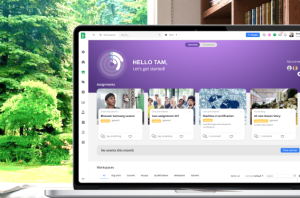Have you ever taught yourself something just for fun or because you wanted to learn more about the topic? Perhaps an intriguing social media post inspired you to follow a particular feed or learn more about a new software feature.
Personal curiosity and inspiration drive individuals to explore various topics, pick up new hobbies, or master new skills. This self-motivation helps people understand and remember information better, heightening interest and motivation leading to expanded knowledge and skill acquisition.
Without self-directed learning, there is a risk of creating knowledge silos, hindering effective knowledge sharing and collaboration across teams.
This blog post will uncover why self-directed learning is critical in the workplace. We will explain the impact on organisations that don’t offer this learning environment. Discover how empowering your team to be self-directed learners can revolutionise your learning and development (L&D) strategy.
What is self-directed learning?
Not to be confused with individuals assigned an e-learning course, who may progress at their own pace without necessarily having heightened interest in completion, a self-directed learner proactively takes the initiative and responsibility for their learning journey.
Instead of relying solely on external guidance, a self-directed learner proactively seeks information, resources, and experiences to acquire knowledge and skills. This type of learner sets their own learning goals and manages their learning process independently. Self-directed learners often engage in activities such as self-study, online courses, reading, and hands-on projects to increase their knowledge and skills.
Let’s put that into perspective and say a self-directed learner might decide to learn a new programming language because they are genuinely interested, actively seeking resources and tutorials, and practicing coding independently. So, rather than being instructed to learn a new programming language or follow a set curriculum without the same level of personal interest or initiative, a self-directed learner takes the reins of their learning journey, demonstrating a proactive and enthusiastic approach to acquiring new skills and knowledge.
The benefits of self-directed learning
Organisations face constant challenges. From rapidly changing markets and technological advancements, like artificial intelligence and automation, to shifts in customer demands and expectations.
Coupled with the diverse needs and preferences of a modern workforce, where employees are working remotely and on-site, embracing innovative strategies for skills and development is no longer a nice to have but a must-have.
To navigate complexities related to talent management and the continuous pursuit of innovation, empowering your workforce to become self-directed learners is essential for staying competitive.
Democratise your learning environment by accommodating different work environments. Ensure each employee has the tools and autonomy to manage their professional development proactively and reap the benefits next.
1. Increased employee engagement
Some 77% of employees are disengaged at work. Disengaged workers are likelier to seek alternative employment, leading to higher turnover rates and associated recruitment costs.

Plus, disengaged employees are often less motivated and productive, reducing overall work output and efficiency. When considering those in customer-facing roles, employees may provide subpar service, negatively impacting customer satisfaction and loyalty.
A lack of engagement can compromise the quality of work, potentially affecting your reputation and customer satisfaction. This, in turn, has the potential to influence team morale, creating ripple effects on the atmosphere and motivation levels within the workplace.
Empowering individuals to control their learning boosts engagement, as employees actively participate in their professional growth. Allowing autonomy in professional development can increase employee satisfaction and retention, making individuals feel valued and supported in their ongoing development within the organisation.
2. Tailored skill development
Tailored skill development allows for flexibility in the pace of learning, enabling individuals to progress at a comfortable and effective rate.
Customise learning experiences to align with individuals’ or groups’ specific needs, goals, and roles. This involves designing educational programs, training modules, or learning activities that address learners’ unique requirements and aspirations. The content and skills taught directly apply to the participants’ roles, immediately making them practical and applicable.
Let’s imagine an employee working in the marketing department of an IT company. This employee, empowered with self-directed learning, identifies a growing trend in digital marketing about data analytics.
Recognising the relevance of this skill to their role and future career aspirations, they tailor their learning. They seek online courses, attend webinars, and engage in hands-on projects to enhance data analytics skills. This targeted approach aligns with their career goals and brings valuable expertise to their current role in the marketing team, contributing to the company’s success.
3. Adaptability to changing roles
As the world of work is a constantly moving target, it’s no surprise adaptability has become the crucial soft skill employers seek. In fact, a McKinsey & Company study found that individuals skilled in adaptability had a 24% higher likelihood of being employed.
Self-directed learning equips employees to quickly adapt to changing job roles and responsibilities, enhancing their versatility and agility within your organisation.
Farooq, an employee at a marketing agency, has been primarily working on social media campaigns for the past couple of years. Recognising his interest and proficiency in data analysis, he desires to take on a more analytical role within the team.
With the support of his manager, Farooq undergoes a role change. He begins to engage in self-directed learning, attending workshops focused on data analytics. His adaptability and learning commitment enable him to grasp complex analytical concepts quickly.
Empower your people to remain resilient and adaptable. Offer a range of development opportunities that spark interest and curiosity. Help employees become valuable assets as they adapt to new roles and responsibilities.
4. Boosted confidence and motivation
Alarmingly, only 15% of employees worldwide feel motivated. Autonomy in professional development enhances individuals’ confidence and motivation as they witness their progress and accomplishments through self-directed learning initiatives. It’s hardly surprising that progress toward career goals is the number one motivator for people to learn, according to LinkedIn’s 2023 Workplace Learning Report.
Self-directed learning provides a pathway for individuals to build confidence through achieving tangible progress. Increase confidence by allowing individuals to learn at a pace that suits their understanding, ensuring a thorough comprehension of concepts before moving on to new topics.
Blossom’s feedback features create a positive loop: setting, achieving, and surpassing learning goals. This boosts confidence and motivation, making individuals more proactive in learning.
5. Personalised learning paths
Self-directed learning allows employees to follow a customised learning path, choosing materials and methodologies that align with their unique learning preferences. This creates a more enjoyable and effective learning experience.
As personalised learning paths enhance the relevance of self-directed learning by providing a structured yet flexible framework, it caters to individual preferences. Employees can explore a range of learning programmes aligned with unique learning preferences by selecting a mix of blended learning and face-to-face training modules. For instance, choosing hands-on practical training over traditional lectures.
Not only that, personalised learning paths optimise the use of resources by focusing on the specific areas that need improvement-aligning with the idea of efficient self-directed learning. This ensures learners spend time where it matters most to them.
Blossom is a flexible and fully modular platform that enables personalised learning paths for each employee’s unique needs and interests. As employees advance in courses, the platform adjusts difficulty and content based on their skills. Tailoring learning to specific skill sets relevant to individual roles and career aspirations ensures a more targeted and practical skill development process.

“Blossom has saved Guberman Group significant time, especially for our managers and the coaches/buddies for new employees. It has streamlined the way we work through having accessible content that is relevant to the employee skill level, seniority, and qualification levels.”
Bar Ostrovsky, Internal Auditor at Guberman Group
6. Enhanced problem-solving skills
Self-directed learners like learning independently, want to know more, and are good at solving problems. This is because they actively work on developing strong problem-solving skills by finding solutions and dealing with challenges on their own.
As self-directed learners encounter problems, they explore innovative solutions. Thinking creatively and adapting independently allows employees to navigate issues with a unique and resourceful mindset.
Let’s say a marketing expert participates in a self-directed learning program focused on digital marketing skills. As he progresses through the materials, he encounters a common challenge: understanding the latest trends in social media algorithms, a vital part of effective digital marketing.
Rather than waiting for formal instruction, he takes the initiative to explore online resources and participate in industry forums. By doing so, he gained insights into the current algorithms and collaboratively developed innovative strategies to leverage these algorithms for marketing purposes.
Self-directed learning encourages the development of critical thinking skills as learners analyse information, make decisions, and solve problems independently.
7. Improved knowledge retention
Let’s face it, investing in upskilling and reskilling initiatives involves a financial commitment, and maximising the return on this investment is crucial.
Why?
Because investing in upskilling and reskilling becomes more valuable when employees can draw upon their retained knowledge to make informed decisions, contribute effectively to projects, and adapt to changing job requirements.
And when employees actively engage in self-directed learning, particularly in areas relevant to their roles or career aspirations, they are more likely to retain the knowledge acquired during training. This means that employees not only grasp the information during training but also retain it over time. This durability of knowledge becomes evident when employees encounter real-world challenges or opportunities to apply what they’ve learned.
Promote a continuous learning culture with self-directed learning
Self-directed learning, supported by technology and platforms like Blossom, has enormous benefits. The effects of self-directed learning go beyond just acquiring specific skills and influence cognitive, emotional, and interpersonal aspects of an individual’s growth.
Promote a workplace culture where self-directed learning is encouraged. Encourage autonomy in professional development where employees take the initiative to stay updated and acquire new skills throughout their careers.
Empower your people to become self-directed learners with Blossom. Our learning specialists will walk you through our platform and discuss your organisational needs. Book a demo today.







